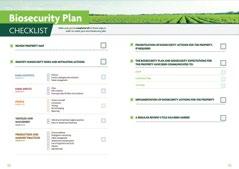
6 minute read
On-farm biosecurity series: Harvest and production practices
ON-FARM BIOSECURITY SERIES:
HARVEST AND PRODUCTION PRACTICES
Anna Rathé : HortNZ biosecurity manager
While we often think of biosecurity risk in terms of what crosses the boundaries of a site, what happens on-site is also important from a biosecurity perspective.
Conducting your everyday production practices in ways that reduce the chance of spreading undetected (or established) pests, pathogens and weeds is worthwhile. This is especially important during busy times such as harvest when increased site activity can cause people to cut corners with biosecurity risk management.
Protocols for production practices should be included in your on-farm biosecurity plan. Contact your industry body to see if they have a crop-specific template that you can use. If not, you can use the HortNZ template available online. Some of the common risk areas associated with production practices are explored below, along with risk reduction actions for you to consider.
Crop surveillance
Keeping a close eye on your crop gives you the best chance of spotting anything unusual that might be a biosecurity threat. Make sure you have a regular monitoring programme in place and keep records, including when you don‘t find anything. It can be very useful to know that regular monitoring has been undertaken but not picked anything up. Ensure your staff are familiar with what is ‘normal‘ and are aware of the key biosecurity threats for your crop, so they know what is unusual and needs to be reported.
Propagation
Undertaking propagation in designated areas away from crops and practising good hygiene will minimise the likelihood of pests and pathogens spreading via plants that have been grown on-site. Regular use of disinfectant for hands, potting benches and tools is important, particularly before and after handling plant material or soil.
Water sources
Site water sources contaminated with pests or pathogens have the potential to spread the organism across the whole property via irrigation water. Water sources should be inspected for weeds or pests and, if in doubt, test water supplies for pathogens that may be harder to detect visually.
Weeds and volunteer plants
Some weed species and volunteer plants (self-seeded crop plants growing in riparian areas) can provide a refuge for pests or pathogens during or between growing seasons. Control weeds and volunteer plants on your property to reduce the chance of them harbouring unwanted pests or pathogens that might later move into your crop. Pest, disease and weed issues often spill over property boundaries, so it can be helpful to consult with neighbours on any pest issues that you are facing.
Use of equipment and tools
Equipment and tools used for production and harvest should be subject to appropriate use, hygiene, and storage practices. If possible, assign tools or equipment exclusively to a property and don‘t share equipment with other growers. When working in a row or block, wash tools regularly and disinfect with an appropriate product.
When undertaking activities in high-risk areas from a biosecurity perspective, assign dedicated equipment, including tools, clothing and footwear. If working in an orchard or on a farm where any disease is present, always move from the least diseased area to the most diseased area. Tools used in parts of the crop that are known to be infested should not be used elsewhere.
Ensure equipment used during harvest such as bins, crates and pallets, are appropriately cleaned or disinfected before use. They should also be as free as possible of any plant debris or soil acquired in the field before moving to the packhouse.
Agrichemicals
Careful use of agrichemicals is important to avoid the development of pest resistance. Ensure your staff are well trained in proper use of agrichemicals. Apply chemicals following their label instructions for rate, method and expiry date and keep appropriate records of their use.
In conclusion
The above is not an exhaustive list. You should identify any additional production practices that you undertake on your site and think about how to minimise any potential biosecurity risk they may pose.
Remember if you see anything unusual, do the right thing and report any suspect exotic pests or diseases via the Ministry for Primary Industries‘ pest and disease hotline: 0800 80 99 66.
Disclaimer: While every effort has been made to ensure the information in this publication is accurate, HortNZ does not accept any responsibility or liability for error of fact, omission, interpretation or opinion that may be present, nor for the consequences of any decisions based on this information.




From common ground to uncommon profit
Invest in a high-return kiwifruit orchard alongside Southern Cross Horticulture

Own a proportional share in an industry-leading orchard with Southern Cross Horticulture. We hand-pick opportunities and our unique ‘end-to-end’ process delivers care and control all the way through. If you share our values and you’re an eligible wholesale investor, then take advantage of this limited window for investment.
Disclaimer: This is not a regulated offer for the purposes of the Financial Markets Conduct Act 2013 (FMCA) and is not an offer of financial products to the public. Any offer will be specified in a separate information memorandum. SCH offers are only open to investors who fall within the exclusions applicable to offers made to “wholesale investors” as set out in Schedule 1, clauses 3(2)(a) to (c) and 3(3)(a) to (b) of the FMCA. SCH requires investors to certify that they fit within one of the above categories of wholesale investors in order to be eligible for consideration to participate in an investment. All prospective investors are recommended to obtain independent professional advice.
Current opportunity:
Hereford Park LP
Expected IRR over 10 years: 10.1%

Minimum investment: $250,000
Partner with SCH, who invest their own money alongside yours
We’re in the kiwifruit industry for the long-haul, but we’re not trying to go it alone. We welcome long-term co-investors in our hand-picked investment orchards. We invest our money alongside yours so our interests are aligned, and we put it to work building lasting assets that generate long-term returns.
Some red, some gold, some existing, some new. The partnership also becomes eligible to invest in Zespri shares. Our primary focus is long term sustainable cash yields paid out to investors.
Diversified exposure to the highest margin parts of the Zespri kiwifruit story
Hereford Park:
24% New RubyRed 17% Existing SunGold 59% New SunGold
Zespri kiwifruit variants
Find out if investing in our Hereford Park Limited Partnership is right for you
schort.co.nz/invest
Te Puke, Western Bay of Plenty
Ownership share
15% Dunstan Group 85% Co-investors
YOUR INDUSTRY
ACROSS THE SECTOR – ACROSS THE COUNTRY
27 GARLIC GROWING











